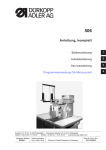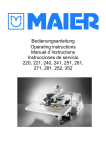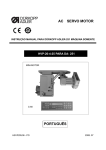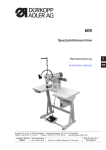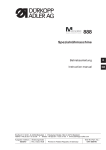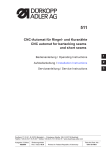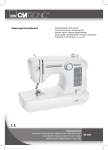Download DURKOPP ADLER 367 - INSTRUCTIONS FOR FITTING FOR KIT 0367 595144 Instruction manual
Transcript
367 Anbauanleitung für Bausatz 0367 595144 Instructions for fitting for kit 0367 595144 Pneumatische Fußlüftung D Sewing foot lift with pedal GB Postfach 17 03 51, D-33703 Bielefeld • Potsdamer Straße 190, D-33719 Bielefeld Telefon +49 (0) 5 21 / 9 25-00 • Telefax +49 (0) 5 21 / 9 25 24 35 • www.duerkopp-adler.com Ausgabe / Edition: 04/2010 Änderungsindex Rev. index: 01.0 Printed in Federal Republic of Germany Teile-Nr./Part.-No.: 0791 367704 Vorwort Diese Anleitung soll erleichtern, die Maschine kennenzulernen und ihre bestimmungsmäßigen Einsatzmöglichkeiten zu nutzen. Die Betriebsanleitung enthält wichtige Hinweise, die Maschine sicher, sachgerecht und wirtschaftlich zu betreiben. Ihre Beachtung hilft, Gefahren zu vermeiden, Reparaturkosten und Ausfallzeiten zu vermindern und die Zuverlässigkeit und die Lebensdauer der Maschine zu erhöhen. Die Betriebsanleitung ist geeignet, Anweisungen aufgrund bestehender nationaler Vorschriften zur Unfallverhütung und zum Umweltschutz zu ergänzen. Die Betriebsanleitung muß ständig am Einsatzort der Maschine/Anlage verfügbar sein. Die Betriebsanleitung ist von jeder Person zu lesen und anzuwenden, die beauftragt ist, an der Maschine/Anlage zu arbeiten. Darunter ist zu verstehen: – – – Bedienung, einschließlich Rüsten, Störungsbehebung im Arbeitsablauf, Beseitigung von Produktionsabfällen, Pflege, Instandhaltung (Wartung, Inspektion, Instandsetzung) und/oder Transport Der Bediener hat mit dafür zu sorgen, daß nur autorisierte Personen an der Maschine arbeiten. Der Bediener ist verpflichtet, die Maschine mindestens einmal pro Schicht auf äußerlich erkennbare Schäden und Mängel zu prüfen, eingetretene Veränderungen (einschließlich des Betriebsverhaltens), die die Sicherheit beeinträchtigen, sofort zu melden. Das verwendende Unternehmen hat dafür zu sorgen, daß die Maschine immer nur in einwandfreiem Zustand betrieben wird. Es dürfen grundsätzlich keine Sicherheitseinrichtungen demontiert oder außer Betrieb gesetzt werden. Ist die Demontage von Sicherheitseinrichtungen beim Rüsten, Reparieren oder Warten erforderlich, hat unmittelbar nach Abschluß der Wartungs- oder Reparaturarbeiten die Remontage der Sicherheitseinrichtungen zu erfolgen. Eigenmächtige Veränderungen an der Maschine schließen eine Haftung des Herstellers für daraus resultierende Schäden aus. Alle Sicherheits- und Gefahrenhinweise an der Maschine/Anlage beachten! Die gelb/schwarz gestreiften Flächen sind Kennzeichnungen ständiger Gefahrenstellen, z. B. mit Quetsch-, Schneid-, Scher- oder Stoßgefahr. Beachten Sie neben den Hinweisen in dieser Betriebsanleitung die allgemein gültigen Sicherheits- und Unfallverhütungs-Vorschriften. Allgemeine Sicherheitshinweise Die Nichteinhaltung folgender Sicherheitshinweise kann zu körperlichen Verletzungen oder zu Beschädigungen der Maschine führen. 1. Die Maschine darf erst nach Kenntnisnahme der zugehörigen Betriebsanleitung und nur durch entsprechend unterwiesene Bedienpersonen in Betrieb genommen werden. 2. Lesen Sie vor Inbetriebnahme auch die Sicherheitshinweise und die Betriebsanleitung des Motorsherstellers. 3. Die Maschine darf nur ihrer Bestimmung gemäß und nicht ohne die zugehörigen Schutzeinrichtungen betrieben werden; dabei sind auch alle einschlägigen Sicherheitsvorschriften zu beachten. 4. Beim Austausch von Nähwerkzeugen (wie z.B. Nadel, Nähfuß, Stichplatte, Stoffschieber und Spule), beim Einfädeln, beim Verlassen des Arbeitsplatzes sowie bei Wartungsarbeiten ist die Maschine durch Betätigen des Hauptschalters oder durch Herausziehen des Netzsteckers vom Netz zu trennen. 5. Die täglichen Wartungsarbeiten dürfen nur von entsprechend unterwiesenen Personen durchgeführt werden. 6. Reparaturarbeiten sowie spezielle Wartungsarbeiten dürfen nur von Fachkräften bzw. entsprechend unterwiesenen Personen durchgeführt werden. 7. Für Wartungs- und Reparaturarbeiten an pneumatischen Einrichtungen ist die Maschine vom pneumatischen Versorgungsnetz (max. 7 - 10 bar) zu trennen. Vor dem Trennen ist zunächst eine Druckentlastung an der Wartungseinheit vornehmen. Ausnahmen sind nur bei Justierarbeiten und Funktionsprüfungen durch entsprechend unterwiesene Fachkräfte zulässig. 8. Arbeiten an der elektrischen Ausrüstung dürfen nur von dafür qualifizierten Fachkräften durchgeführt werden. 9. Arbeiten an unter Spannung stehenden Teilen und Einrichtungen sind nicht zulässig. Ausnahmen regeln die Vorschriften DIN VDE 0105. 10. Umbauten bzw. Veränderungen der Maschine dürfen nur unter Beachtung aller einschlägigen Sicherheitsvorschriften vorgenommen werden. 11. Bei Reparaturen sind die von uns zur Verwendung freigegebenen Ersatzteile zu verwenden. 12. Die Inbetriebnahme des Oberteils ist so lange untersagt, bis festgestellt wurde, dass die gesamt Näheinheit den Bestimmungen der EG-Richtlinien entspricht. 13. Das Anschlusskabel muss mit einem landesspezifischen zugelassenem Netzstecker versehen werden. Hierfür ist eine qualifizierte Fachkraft erforderlich (sh. auch Pkt. 8). Diese Zeichen stehen vor Sicherheitshinweisen, die unbedingt zu befolgen sind. Verletzungsgefahr ! Beachten Sie darüber hinaus auch die allgemeinen Sicherheitshinweise. Inhalt Seite: Vorwort und allgemeine Sicherheitshinweise Einbau der pneumatischen Fußlüftung Klasse 367 (Ausgabe 04.2010) 1. Allgemeine Information 1.1 Lieferumfang . . . . . . . . . . . . . . . . . . . . . . . . . . . . . . . . . . . . . . . . . . . . . . . . . . 3 2. 2.1 2.2 2.3 Einbau Schubstange durch Zylinder ersetzen . . . . . . . . . . . . . . . . . . . . . . . . . . . . . . . . . . Gestänge durch neues Gestänge ersetzen . . . . . . . . . . . . . . . . . . . . . . . . . . . . . . . . Wartungseinheit anbringen und anschließen . . . . . . . . . . . . . . . . . . . . . . . . . . . . . . 4 6 7 D 1. Allgemeine Informationen Die Unterklasse 367-170010 kann mit der pneumatischen Fußlüftung nachgerüstet werden. ACHTUNG! Der Betriebsdruck der Klasse 367 ist 6 bar. Sollte der Druck Ihrer Versorgungsleitung höher als 6 bar sein, muss der Druck an der Versorgungseinheit der Nähmaschine auf 6 bar reduziert werden! 1.1 Lieferumfang Bevor Sie mit dem Einbau beginnen: Bitte überprüfen Sie, ob alle Bauteile des Nachrüstsatzes in dem Lieferumfang enthalten sind. Der komplette Bausatz für die pneumatische Fußlüftung mit der Bestellnummer: 0367 595144 besteht aus folgenden Komponenten: Bauteil Teilenummer 1 9780 982005 Schalldämpfer 1,3 m Schlauch 9731 005004 1 Verbindung WI-N 9790 010010 2 Verschraubung GD-E 9790 200001 1 Verschraubung WI-E 9790 201001 1 Zylinder 0367 135174 1 Gestänge Z 100 000343 1 Befestigungsschelle 9840 120026 1 Wartungseinheit 9780 000108 1 Druckleitung 0797 003031 1 Kupplungsdose 0744 001793 A 1 Kupplungsstecker (an Druckleitung) 0744 001793 B 2 Ideal-Schelle (1x an Druckleitung) 0742 002096 1 Schlauchtülle 0744 001796 1 Innensechskantschraube 9202 002077 1 Pneumatik-Geräteplan 9770 367503 D 3 2. Einbau Vorsicht Verletzungsgefahr! Schalten Sie den Hauptschalter aus und ziehen Sie den Netzstecker, bevor sie mit dem Einbau der pneumatischen Fußlüftung beginnen. Der Einbau darf nur von qualifizierten Technikern durchgeführt werden. – – Kippen Sie die Nähmaschine nach hinten ab. Lösen Sie die 6 Schrauben der Ölwanne und nehmen Sie die Ölwanne ab. 2.1 Schubstange durch Zylinder ersetzen 1 7 4 2 8 1 3 4 5 3 6 – Entfernen Sie an der Schubstange 2 rechts die Sicherungsscheibe 3 und links die Schraube 1. – Ziehen Sie die Schubstange 2 rechts von dem Zapfen. – Führen Sie den Schlauch 6 durch die Halterung 5 an der Maschinenrückwand. – Schieben Sie den Schlauch 6 auf den Anschluss 8 des Zylinders 4. – Bauen Sie den Zylinder 4 an Stelle der Schubstange 2 ein. Der Kolben muss dabei nach rechts zeigen und die Drosselschraube 7 muss nach unten zeigen. Drehen Sie die Drosselschraube 7 gegen den Uhrzeigersinn, bewegt sich der Kolben schneller. Der Nähfuß wird schneller gelüftet. Drehen Sie die Drosselschraube 7 im Uhrzeigersinn, bewegt sich der Kolben langsamer. Der Nähfuß wird langsamer gelüftet. – Setzen Sie an dem Zylinder 4 rechts die Sicherungsscheibe 3 wieder auf und drehen sie links die Schraube 1 wieder ein. – Führen Sie den Schlauch 6 an der Maschinenrückwand nach rechts. Führen Sie den Schlauch durch die Ausfräsung 9 rechts unten an der Nähmaschine nach außen. 6 9 10 11 12 – Mit der Verbindung WI-N 12 müssen Sie jetzt den Schlauch nach unten führen. – Stecken Sie dazu die Befestigungsschelle 10 auf den Schlauch 6. Um die Länge des Schlauches 6 abzumessen, halten Sie die Befestigungsschelle 10 an die Bohrung rechts unten an der Nähmaschine. Schneiden Sie den Schlauch 6 hinter der Befestigungsschelle 10 ab. – Verbinden Sie die Schlauchenden mit der Verbindung WI-N 12. – Schrauben Sie den Schlauch 6 mit der Befestigungsschelle 10, direkt an der Verbindung WI-N 12 mit der Innensechskantschraube 11, an die Bohrung rechts unten an der Nähmaschine. Führen Sie das lose Schlauchende unter das Untergestell. Setzen Sie die Ölwanne auf und ziehen Sie die 6 Schrauben an. Kippen Sie die Nähmaschine wieder nach vorn. – – D Hinweise Sollten Sie die Nähleuchte 9822 510001 eingebaut haben, werden sowohl der Schlauch als auch das Kabel der Beleuchtung an die Bohrung rechts unten an der Nähmaschine angeschraubt. Die im Lieferumfang enthaltene Innensechskantschraube 11 ist lang genug, um 2 Befestigungsschellen anzuschrauben. 5 2.2 Gestänge durch neues Gestänge ersetzen 1 6 2 3 4 5 6 7 – Schrauben Sie in die obere Bohrung den Schalldämpfer 7 ein. Schrauben Sie in die beiden anderen Bohrungen die Verschraubungen GD-E 5 und 6 ein. Ziehen Sie die Verschraubungen 5 und 6 an, damit die Gewinde mit der aufgetragenen Dichtungsmasse richtig abdichtet werden. – Entfernen Sie die Muttern des alten Gestänges an dem Pedal 1 und an dem Antrieb 4. Entfernen Sie das alte Gestänge. – Bauen Sie an Stelle des alten Gestänges das neue Gestänge 3 ein. Stecken Sie die Unterlegscheiben auf und schrauben Sie die Muttern 1 und 4 wieder auf. – Um die Position des Pedals anzupassen, lösen Sie die Schraube 2 Stellen Sie das Pedal passend ein und ziehen Sie die Schraube 2 wieder an. 2.3 Wartungseinheit anbringen und anschließen 8 5 6 12 13 9 D 9 – Schrauben Sie die Schlauchtülle 10 in den würfelförmigen Anschluss 12 der Wartungseinheit 13. – Entfernen Sie das Verbindungsstück 8 mit den Dichtungsscheiben aus der Wartungseinheit 13 und ersetzen Sie es durch die Verschraubung WI-E 9. – Schrauben Sie die Wartungseinheit 13 so an das Untergestell, dass der Wasserabscheider möglichst senkrecht nach unten zeigt. Haben Sie das Untergestell MG 55-3, bringen Sie die Wartungseinheit 13 an die Querstange rechts unterhalb des Antriebs an. Führen Sie den aus der Nähmaschine kommenden Schlauch zu dem neuen Gestänge 3. Schneiden Sie den Schlauch so ab, dass er nicht spannt und stecken Sie ihn in die Verschraubung GD-E 6. Verbinden Sie mit dem restlichen Schlauch die Verschraubung GD-E 5 mit der Verschraubung WI-E 9 an der Wartungseinheit. – – 10 11 – Schrauben Sie die Kupplungsdose 11 an Ihre Druckversorgung. – Stecken Sie die Ideal-Schelle 15 auf die Druckleitung 16. Schieben Sie dann die Druckleitung 16 auf die Schlauchtülle 10 an der Wartungseinheit 13. Sichern Sie mit der Ideal-Schelle 15 die Druckleitung auf dem Anschlussstück 10. – Stecken Sie die Druckleitung 16 mit dem Kupplungsstecker 14 in die Kupplungsdose 11 an Ihrer Druckversorgung. 14 15 16 ACHTUNG! Der Betriebsdruck ist 6 bar. Kontrollieren Sie an der Wartungseinheit, ob 6 bar angezeigt werden! Wenn nötig regeln Sie den Druck an der Wartungseinheit auf 6 bar bevor Sie die pneumatische Fußlüftung betätigen. 7 Für Ihre Notizen: 8 Foreword This instruction manual is intended to help the user to become familiar with the machine and take advantage of its application possibilities in accordance with the recommendations. The instruction manual contains important information on how to operate the machine securely, properly and economically. Observation of the instructions eliminates danger, reduces costs for repair and down-times, and increases the reliability and life of the machine. The instruction manual is intended to complement existing national accident prevention and environment protection regulations. The instruction manual must always be available at the machine/sewing unit. The instruction manual must be read and applied by any person that is authorized to work on the machine/sewing unit. This means: – – – Operation, including equipping, troubleshooting during the work cycle, removing of fabric waste, Service (maintenance, inspection, repair) and/or Transport. The user also has to assure that only authorized personnel work on the machine. The user is obliged to check the machine at least once per shift for apparent damages and to immediatly report any changes (including the performance in service), which impair the safety. The user company must ensure that the machine is only operated in perfect working order. Never remove or disable any safety devices. If safety devices need to be removed for equipping, repairing or maintaining, the safety devices must be remounted directly after completion of the maintenance and repair work. Unauthorized modification of the machine rules out liability of the manufacturer for damage resulting from this. Observe all safety and danger recommendations on the machine/unit! The yellow-and-black striped surfaces designate permanend danger areas, eg danger of squashing, cutting, shearing or collision. Besides the recommendations in this instruction manual also observe the general safety and accident prevention regulations! General safety instructions The non-observance of the following safety instructions can cause bodily injuries or damages to the machine. 1. The machine must only be commissioned in full knowledge of the instruction book and operated by persons with appropriate training. 2. Before putting into service also read the safety rules and instructions of the motor supplier. 3. The machine must be used only for the purpose intended. Use of the machine without the safety devices is not permitted. Observe all the relevant safety regulations. 4. When gauge parts are exchanged (e.g. needle, presser foot, needle plate, feed dog and bobbin) when threading, when the workplace is left, and during service work, the machine must be disconnected from the mains by switching off the master switch or disconnecting the mains plug. 5. Daily servicing work must be carried out only by appropriately trained persons. 6. Repairs, conversion and special maintenance work must only be carried out by technicians or persons with appropriate training. 7. For service or repair work on pneumatic systems, disconnect the machine from the compressed air supply system (max. 7-10 bar). Before disconnecting, reduce the pressure of the maintenance unit. Exceptions to this are only adjustments and functions checks made by appropriately trained technicians. 8. Work on the electrical equipment must be carried out only by electricians or appropriately trained persons. 9. Work on parts and systems under electric current is not permitted, except as specified in regulations DIN VDE 0105. 10. Conversion or changes to the machine must be authorized by us and made only in adherence to all safety regulations. 11. For repairs, only replacement parts approved by us must be used. 12. Commissioning of the sewing head is prohibited until such time as the entire sewing unit is found to comply with EC directives. 13. The line cord should be equipped with a country-specific mains plug. This work must be carried out by appropriately trained technicians (see paragraph 8). It is absolutely necessary to respect the safety instructions marked by these signs. Danger of bodily injuries ! Please note also the general safety instructions. Index Page: Preface and general safety hints Fitting the pneumatic foot lift class 367 (Edition 04/2010) 1. General information 1.1 Scope of delivery . . . . . . . . . . . . . . . . . . . . . . . . . . . . . . . . . . . . . . . . . . . . . . . 3 2. 2.1 2.2 2.3 Fitting Replace the slide bar by a cylinder . . . . . . . . . . . . . . . . . . . . . . . . . . . . . . . . . . . . Replace bars by new bars . . . . . . . . . . . . . . . . . . . . . . . . . . . . . . . . . . . . . . . . . . Fit and connect maintenance unit . . . . . . . . . . . . . . . . . . . . . . . . . . . . . . . . . . . . . 4 6 7 GB 1. General information The subclass 367-170010 can be retrofitted with the pneumatic foot lift. ATTENTION! The operating pressure of class 367 amounts to 6 bar. Should the pressure of your supply line be higher than 6 bar, it has to be reduced to 6 bar at the supply unit of the sewing machine! 1.1 Scope of delivery Before you start the installation: Please check whether all components of the retrofit kit are included in the scope of delivery. The complete mounting kit for the pneumatic foot lift with the order number 0367 595144 consists of the following components: Component Parts number 1 9780 982005 Sound absorber 1.3 m Hose 9731 005004 1 Connection WI-N 9790 010010 2 Screw connection GD-E 9790 200001 1 Screw connection WI-E 9790 201001 1 Cylinder 0367 135174 1 Bars Z 100 000343 1 Fastening clip 9840 120026 1 Maintenance unit 9780 000108 1 Pressure line 0797 003031 1 Coupling box 0744 001793 A 1 Coupling plug (at the pressure line) 0744 001793 B 2 Ideal clip (1x at the pressure line) 0742 002096 1 Hose nozzle 0744 001796 1 Allen screw 9202 002077 1 Pneumatic device plan 9770 367503 GB 3 2. Fitting Caution: Danger of injury! Switch off the main switch and pull out the mains plug before you start to install the pneumatic foot lift. The installation must be done by qualified technicians only. – – Tilt the sewing machine to the back. Loosen the 6 screws of the oil pan and take the oil pan off. 2.1 Replace the slide bar by a cylinder 1 7 4 2 1 3 4 5 3 6 – Remove the locking washer 3from the right end of the slide bar 2 and the screw 1 from the left end of the slide bar 2. – Remove the slide bar 2 from the finger on the right. – Run the hose 6 through the fixture 5 at the rear panel of the machine. – Push the hose 6 on the connection 8 of the cylinder 4. – Fit the cylinder 4 instead of the slide bar 2. The piston must show to the right and the throttling screw 7 must show down. If you turn the throttling screw 7 counter-clockwise, the piston is moving more quickly. The sewing foot is lifted more quickly. If you turn the throttling screw 7 in clockwise direction, the piston is moving more slowly. The sewing foot is lifted more slowly. – Put the locking washer 3 on the right of the cylinder 4 again and screw in screw 1 on the left again. – Run the hose 6 to the right at the rear panel of the machine. Run the hose outside through the cut-out 9 down on the right of the sewing machine. 8 6 9 10 11 12 – Now you have to guide the hose downward with the connection WI-N 12. – For this purpose put the fastening clip 10 on the hose 6. In order to measure the length of the hose 6, hold the fastening clip 10 close to the drill-hole down on the right of the sewing machine. Cut the hose 6 off behind the fastening clip 10. – Connect the hose ends with the connection WI-N 12. – Screw the hose 6 with the fastening clip 10 (directly at the connection WI-N 12 with the Allen screw 11) on the drill-hole down on the right of the sewing machine. Guide the loose end of the hose underneath the stand. Put the oil pan on and tighten the 6 screws. Tilt the sewing machine to the front again. – – GB Hints In case you have installed the sewing light 9822 510001, not only the hose but also the cable of the lighting are screwed on the drill-hole down on the right of the sewing machine. The Allen screw 11 included in the accessories is long enough to tighten 2 fastening clips. 5 2.2 Replace bars by new bars 1 6 2 3 4 5 6 7 – Screw the sound absorber 7 in the upper drill-hole. Screw the screw connections GD-E 5 and 6 in the other two drill-holes. Tighten the screw connections 5 and 6 so that the threads are correctly sealed by the applied sealing compound. – Remove the nuts of the old bars at pedal 1 and drive 4. Remove the old bars. – Fit the new bars 3 instead of the old bars. Put on the washers and screw on the nuts 1 and 4 again. – Loosen screw 2 in order to adjust the position of the pedal. Adjust the pedal to fit and tighten the screw 2 again. 2.3 Fit and connect the maintenance unit 8 5 9 Screw the hose nozzle 10 in the cubical-shaped connection 12 of the maintenance unit 13. – Remove the connecting piece 8 with the washers from the maintenance unit 13 and replace it by the screw connection WI-E 9. – Screw the maintenance unit 13 on the stand in such a way that the water separator shows downward in a vertical direction. If you have got the stand MG 55-3, fit the maintenance unit 13 at the cross bar on the right beneath the drive. Guide the hose coming out of the sewing machine to the new bars 3. Cut the hose off in such a way that it is not under tension and push it into the screw connection GD-E 6. – 11 12 13 – 9 10 6 GB – Connect the screw connection GD-E 5 and the screw connection WI-E 9 at the maintenance unit with the remaining hose. – Screw the coupling box 11 on your pressure supply. – Put the Ideal clip 15 on the pressure line 16. Then push the pressure line 16 on the hose nozzle 10 at the maintenance unit 13. Secure the pressure line on the connection piece 10 by the Ideal clip 15. – Plug the coupling plug 14 of the pressure line 16 in the coupling box 11 of your pressure supply. 14 15 16 ATTENTION! The operating pressure amounts to 6 bar. Check at the maintenance unit whether 6 bar is indicated! If necessary, adjust the pressure at the maintenance unit to 6 bar before actuating the pneumatic foot lift. 7 Your own notes: 8






















